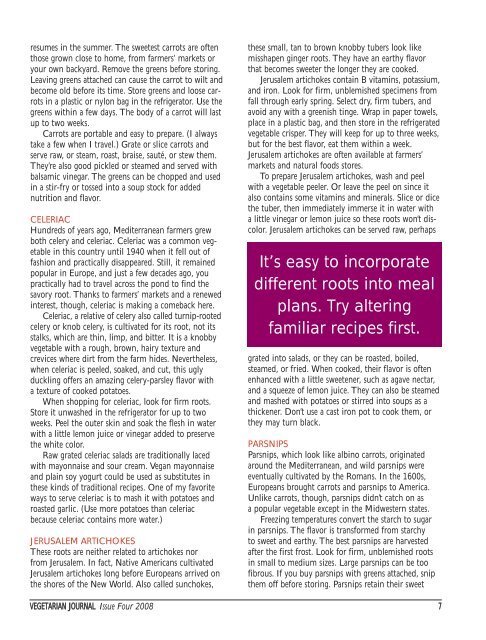An Update on Gelatin Top Restaurant Chains for Vegetarians
An Update on Gelatin Top Restaurant Chains for Vegetarians
An Update on Gelatin Top Restaurant Chains for Vegetarians
Create successful ePaper yourself
Turn your PDF publications into a flip-book with our unique Google optimized e-Paper software.
esumes in the summer. The sweetest carrots are oftenthose grown close to home, from farmers’ markets oryour own backyard. Remove the greens be<strong>for</strong>e storing.Leaving greens attached can cause the carrot to wilt andbecome old be<strong>for</strong>e its time. Store greens and loose carrotsin a plastic or nyl<strong>on</strong> bag in the refrigerator. Use thegreens within a few days. The body of a carrot will lastup to two weeks.Carrots are portable and easy to prepare. (I alwaystake a few when I travel.) Grate or slice carrots andserve raw, or steam, roast, braise, sauté, or stew them.They’re also good pickled or steamed and served withbalsamic vinegar. The greens can be chopped and usedin a stir-fry or tossed into a soup stock <strong>for</strong> addednutriti<strong>on</strong> and flavor.CELERIACHundreds of years ago, Mediterranean farmers grewboth celery and celeriac. Celeriac was a comm<strong>on</strong> vegetablein this country until 1940 when it fell out offashi<strong>on</strong> and practically disappeared. Still, it remainedpopular in Europe, and just a few decades ago, youpractically had to travel across the p<strong>on</strong>d to find thesavory root. Thanks to farmers’ markets and a renewedinterest, though, celeriac is making a comeback here.Celeriac, a relative of celery also called turnip-rootedcelery or knob celery, is cultivated <strong>for</strong> its root, not itsstalks, which are thin, limp, and bitter. It is a knobbyvegetable with a rough, brown, hairy texture andcrevices where dirt from the farm hides. Nevertheless,when celeriac is peeled, soaked, and cut, this uglyduckling offers an amazing celery-parsley flavor witha texture of cooked potatoes.When shopping <strong>for</strong> celeriac, look <strong>for</strong> firm roots.Store it unwashed in the refrigerator <strong>for</strong> up to twoweeks. Peel the outer skin and soak the flesh in waterwith a little lem<strong>on</strong> juice or vinegar added to preservethe white color.Raw grated celeriac salads are traditi<strong>on</strong>ally lacedwith may<strong>on</strong>naise and sour cream. Vegan may<strong>on</strong>naiseand plain soy yogurt could be used as substitutes inthese kinds of traditi<strong>on</strong>al recipes. One of my favoriteways to serve celeriac is to mash it with potatoes androasted garlic. (Use more potatoes than celeriacbecause celeriac c<strong>on</strong>tains more water.)JERUSALEM ARTICHOKESThese roots are neither related to artichokes norfrom Jerusalem. In fact, Native Americans cultivatedJerusalem artichokes l<strong>on</strong>g be<strong>for</strong>e Europeans arrived <strong>on</strong>the shores of the New World. Also called sunchokes,these small, tan to brown knobby tubers look likemisshapen ginger roots. They have an earthy flavorthat becomes sweeter the l<strong>on</strong>ger they are cooked.Jerusalem artichokes c<strong>on</strong>tain B vitamins, potassium,and ir<strong>on</strong>. Look <strong>for</strong> firm, unblemished specimens fromfall through early spring. Select dry, firm tubers, andavoid any with a greenish tinge. Wrap in paper towels,place in a plastic bag, and then store in the refrigeratedvegetable crisper. They will keep <strong>for</strong> up to three weeks,but <strong>for</strong> the best flavor, eat them within a week.Jerusalem artichokes are often available at farmers’markets and natural foods stores.To prepare Jerusalem artichokes, wash and peelwith a vegetable peeler. Or leave the peel <strong>on</strong> since italso c<strong>on</strong>tains some vitamins and minerals. Slice or dicethe tuber, then immediately immerse it in water witha little vinegar or lem<strong>on</strong> juice so these roots w<strong>on</strong>’t discolor.Jerusalem artichokes can be served raw, perhapsIt’s easy to incorporatedifferent roots into mealplans. Try alteringfamiliar recipes first.grated into salads, or they can be roasted, boiled,steamed, or fried. When cooked, their flavor is oftenenhanced with a little sweetener, such as agave nectar,and a squeeze of lem<strong>on</strong> juice. They can also be steamedand mashed with potatoes or stirred into soups as athickener. D<strong>on</strong>’t use a cast ir<strong>on</strong> pot to cook them, orthey may turn black.PARSNIPSParsnips, which look like albino carrots, originatedaround the Mediterranean, and wild parsnips wereeventually cultivated by the Romans. In the 1600s,Europeans brought carrots and parsnips to America.Unlike carrots, though, parsnips didn’t catch <strong>on</strong> asa popular vegetable except in the Midwestern states.Freezing temperatures c<strong>on</strong>vert the starch to sugarin parsnips. The flavor is trans<strong>for</strong>med from starchyto sweet and earthy. The best parsnips are harvestedafter the first frost. Look <strong>for</strong> firm, unblemished rootsin small to medium sizes. Large parsnips can be toofibrous. If you buy parsnips with greens attached, snipthem off be<strong>for</strong>e storing. Parsnips retain their sweetVEGETARIAN JOURNAL Issue Four 2008 7
















